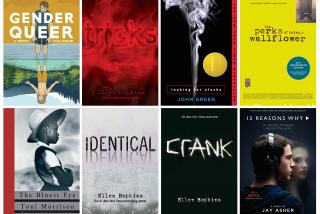Read Between the Lines in This ‘Crisis’
- Share via
Is reading itself “at risk”? That is what the National Endowment for the Arts claimed earlier this summer, and it published a chart-filled report to prove the case. Now NEA Chairman Dana Gioia has gone the next step, announcing that the NEA will spearhead a “national initiative” involving millions of federal dollars to address this crisis.
But is there a crisis at all? I can’t help but hear “The Music Man’s” professor Harold Hill in everything the chairman says. His assertion that the NEA’s study “constitutes a comprehensive factual basis for any informed discussion of current American reading habits” is simply wrong.
Shouldn’t a study of reading, for example, include information gathered from those who have the most contact with readers -- librarians? A source at the Los Angeles Public Library reports that in the first six months of this year, adults checked out 315,000 books, as against 286,000 in the same period last year, and a total of 322,000 for the full year in 2000. Similarly, New York’s Midtown Manhattan library reports that the circulation of fiction is up 150% in the last eight years. How can it be that adults are checking out books from major libraries at a record pace and not reading them?
The answer is that the NEA survey is really a study of participation in the arts, with a few questions on reading wedged in. That is why, with one exception, all of the questions equate “literature” with novels, plays and poetry. Here are just a few of the problems I found by looking past the NEA’s published report to the actual data it compiled. The most recent survey the NEA conducted asks, “With the exception of books required for work or school, did you read any books during the last 12 months?” This is the only question covering all types of reading, and Gioia continually referred back to it in order to prove that reading was in real danger. It did yield the alarming result that in the last 10 years the percentage of adults reading anything at all had gone from 60.9% to 56.6%.
But what do these numbers actually tell us? Let’s start with those qualifiers -- school and work. Only 42.9% of young people ages 18 to 24 answered the question “yes.” The obvious if unasked question is how much reading were they doing in college, in summer internships, in preparation for graduate school or, for that matter, in military manuals. In earlier surveys in which there was no such qualifier, young people answered yes in significantly higher numbers.
For that matter, an executive who spends nights reading books on management, magazine articles on business strategies or biographies of notable leaders might have difficulty deciding which pages were “required” for work.
Unless the NEA asks follow-up questions about required reading, it is in no position to make comprehensive statements about reading. It is the unasked questions that haunt the surveys. Although every performing art is thoroughly investigated with at least 15 questions, there is not a single follow-up question about reading.
There is one question about the Internet and reading, but it emphasizes the limited scope of the survey. It asks, “Do you use the Internet to learn about, listen to or discuss topics related to literature -- novels, poetry or plays?” A news junkie or policy wonk who cannot get enough of the reports he or she downloads would have to answer this by saying no.
Clearly the NEA is concerned about the areas it is designed to foster -- the arts -- and it sees what it calls “literature” as a close cousin. Admirable. But by sprinkling a few questions on reading into a study on participation in the arts, it came up with vague results, and then by exaggerating their significance it undermined the authority of its own survey.
As an editor and author, I’m always happy to have more funds available for reading initiatives. It would be great if the NEA admitted its survey was flawed and put its energy into creating a more carefully crafted study that provided real insight into the nation’s reading habits. But we ought to make sure that what we call a crisis really is one, and not a way to increase funding for government agencies.
*
Marc Aronson is the author of “Exploding the Myths: The Truth About Teenagers and Reading” (Scarecrow, 2001).
More to Read
Sign up for our Book Club newsletter
Get the latest news, events and more from the Los Angeles Times Book Club, and help us get L.A. reading and talking.
You may occasionally receive promotional content from the Los Angeles Times.










